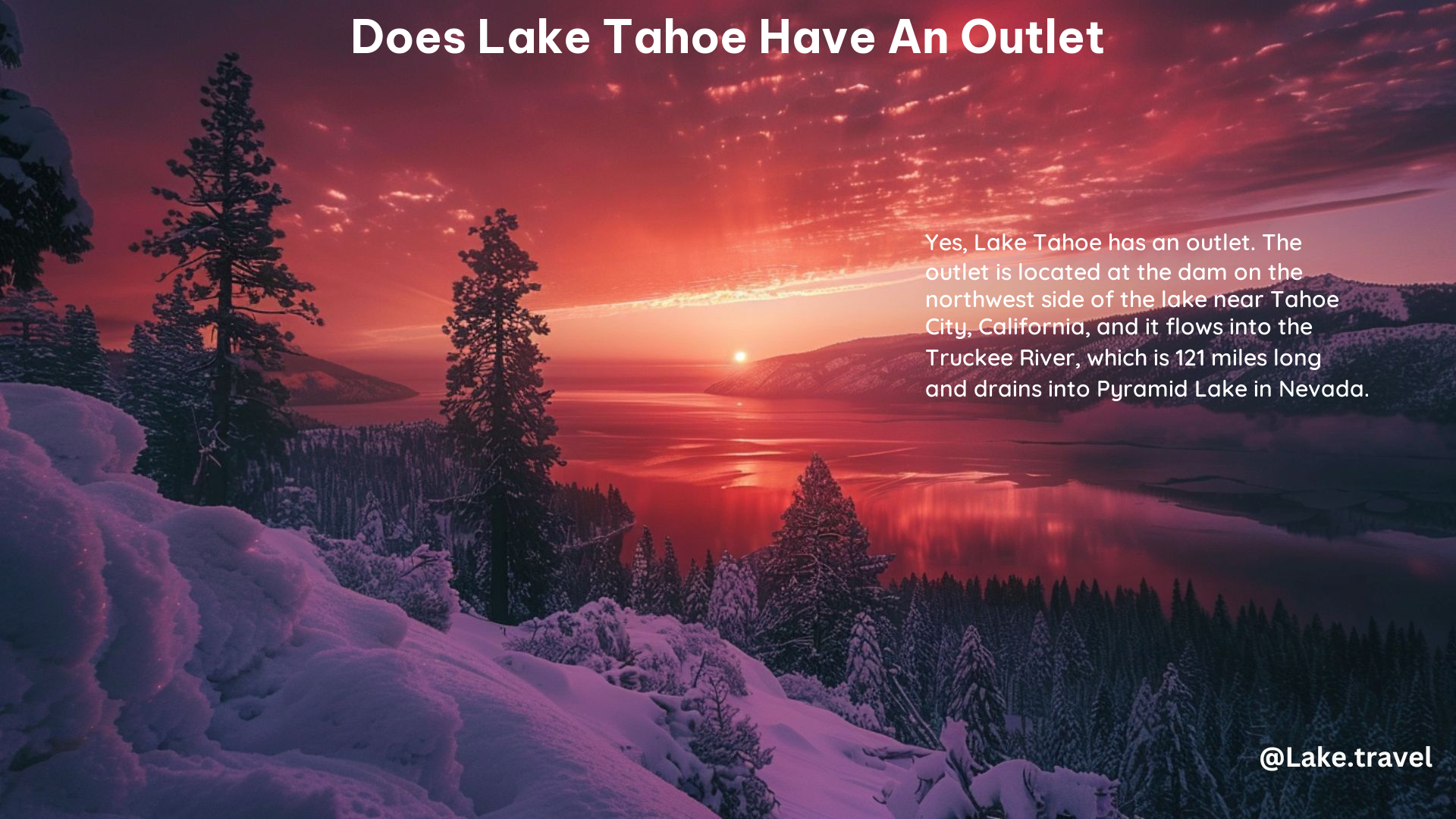Yes, Lake Tahoe has an outlet. The outlet of Lake Tahoe is located at the Truckee River, which flows out of the lake near Tahoe City, California. The lake’s water level is regulated by the Lake Tahoe Dam, a concrete gravity dam built between 1909 and 1913. This dam raises the lake’s water level by up to 10.1 feet and distributes the water into the Truckee River, which then flows into Pyramid Lake in Nevada.
The Truckee River: Lake Tahoe’s Outlet
The Truckee River is the primary outlet for Lake Tahoe. It flows out of the lake near Tahoe City, California, and travels approximately 121 miles (195 km) before emptying into Pyramid Lake in Nevada. The Truckee River is an important source of water for communities in both California and Nevada, and it plays a crucial role in the regional water management system.
The Lake Tahoe Dam
The Lake Tahoe Dam is a concrete gravity dam that was built between 1909 and 1913. The dam is located at the outlet of Lake Tahoe, where the Truckee River begins. The primary purpose of the dam is to regulate the water level of Lake Tahoe, allowing for the controlled release of water into the Truckee River.
Key Facts about the Lake Tahoe Dam:
- Height: 18 feet (5.5 meters)
- Length: 328 feet (100 meters)
- Raises the lake’s water level by up to 10.1 feet (3.1 meters)
- Allows for the controlled release of water into the Truckee River
- Managed by the U.S. Bureau of Reclamation
The Importance of Lake Tahoe’s Outlet

The outlet of Lake Tahoe, the Truckee River, serves several important functions:
-
Water Supply: The Truckee River is a crucial source of water for communities in both California and Nevada, providing drinking water, irrigation, and industrial uses.
-
Flood Control: The Lake Tahoe Dam and the Truckee River outlet help to regulate the water level of the lake, preventing flooding during high-water periods.
-
Ecosystem Maintenance: The Truckee River supports a diverse ecosystem, including various fish species, wildlife, and riparian habitats. The controlled release of water from Lake Tahoe helps to maintain the health of this ecosystem.
-
Recreational Activities: The Truckee River is a popular destination for a variety of recreational activities, such as fishing, kayaking, and rafting.
The Truckee River Basin
The Truckee River basin encompasses an area of approximately 3,060 square miles (7,930 square kilometers), spanning both California and Nevada. The basin includes several major tributaries, including the Little Truckee River, the Donner Creek, and the Prosser Creek.
Key Facts about the Truckee River Basin:
- Total Length of the Truckee River: 121 miles (195 km)
- Drainage Area: 3,060 square miles (7,930 square km)
- Major Tributaries: Little Truckee River, Donner Creek, Prosser Creek
- Flows into Pyramid Lake in Nevada
The Truckee River Watershed Management
The Truckee River and its watershed are managed by a complex system of agreements, regulations, and agencies. This management system is designed to ensure the fair and efficient use of the river’s water resources, as well as the protection of the ecosystem and the various stakeholders.
Key Entities Involved in Truckee River Watershed Management:
-
Truckee River Operating Agreement (TROA): A comprehensive agreement that governs the operation and management of the Truckee River system, including the allocation of water rights and the coordination of water storage and release.
-
Truckee River Watershed Council: A non-profit organization that works to protect and restore the Truckee River watershed through education, advocacy, and collaborative projects.
-
U.S. Bureau of Reclamation: The federal agency responsible for the management and operation of the Lake Tahoe Dam and the Truckee River system.
-
Tahoe Regional Planning Agency (TRPA): A bi-state agency that oversees the environmental protection and land use planning for the Lake Tahoe Basin, including the Truckee River watershed.
-
Nevada Division of Water Resources: The state agency responsible for the management and allocation of water resources in Nevada, including the Truckee River system.
-
California State Water Resources Control Board: The state agency responsible for the management and allocation of water resources in California, including the Truckee River system.
Conclusion
In conclusion, Lake Tahoe does have an outlet, and it is the Truckee River. The Truckee River flows out of the lake near Tahoe City, California, and is regulated by the Lake Tahoe Dam, which raises the lake’s water level by up to 10.1 feet. The Truckee River is a crucial water source for communities in both California and Nevada, and it also plays a vital role in flood control, ecosystem maintenance, and recreational activities. The management of the Truckee River watershed involves a complex system of agreements, regulations, and agencies, all working to ensure the fair and efficient use of the river’s water resources.
Reference:
– Lake Tahoe Basin Management Unit
– Truckee River Watershed Council
– Tahoe Regional Planning Agency
– U.S. Bureau of Reclamation
– Nevada Division of Water Resources
– California State Water Resources Control Board
